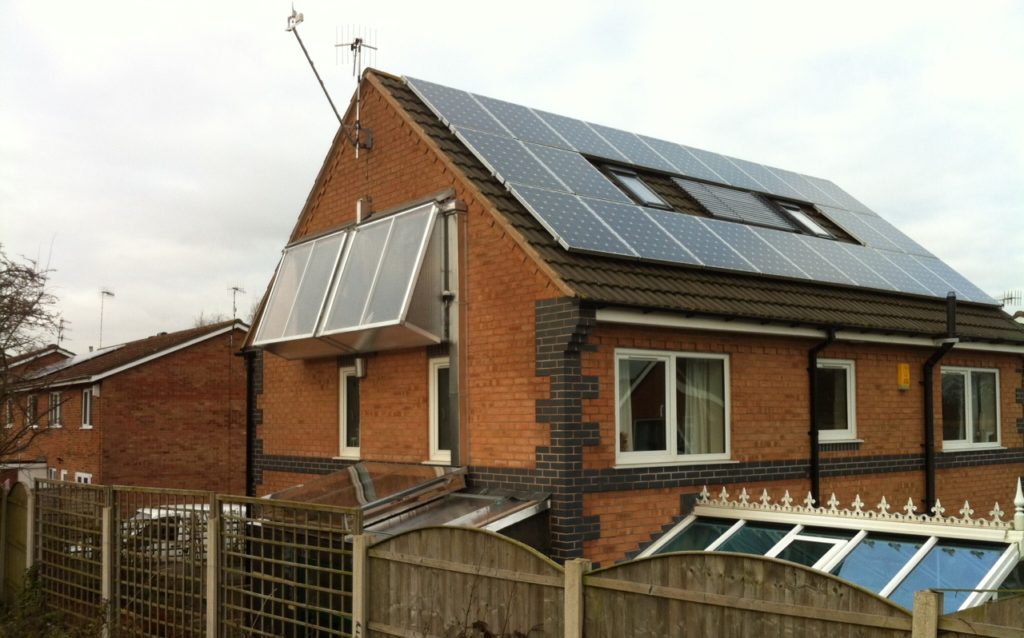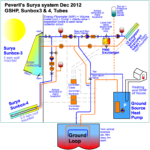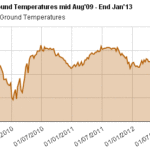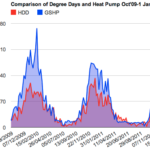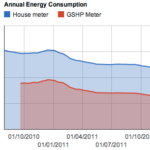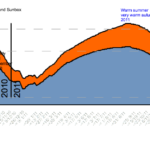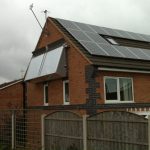Peveril Solar House
There is a 4 kW photovoltaic (PV) array on the east roof, producing 3,200 kWh per annum (averaged over 3 years). During the first two years, the ground source heat pump consumed an estimated 4,800-5,200 kWh/annum. The owner has added 4 sqm of solar thermal panels on the south wall. These deliver approx 2,600 kWh/ annum directly into the deep boreholes, raising the efficiency of the ground source heat pump. The solar panels are swimming pool panels enclosed in a glazed box made of Polycarbonate and ETFE skin. The solar thermal has been added to with 15 Varisol tubes on the east roof which are expected to deliver another 500 kWh annually to the boreholes. There is also a self-constructed solar panel of metal radiators and polycarbonate on the south facing extension roof, which may deliver approx 1000 kWh/annum.
The GSHP has its own meter, so its consumption can be measure accurately. With the help of solar augmentation, it is currently operating in a range of 2,550 to 3,650 kWh annually (averaging 3,200 kWh) for all space heating, hot water and pump circulating requirements. On regulated inputs and outputs measured annually, this makes the building carbon net-zero.
The house started as a modern British developer house 2007, so it has no specific passive features other than good insulation. The heating is provided by liquid circulating underfloor heating on both ground and first floor. Heat is delivered by a ground source heat pump working to twin 48m deep boreholes next to the house. The kitchen environment is assisted by a single zone MVHR unit. Reliable heating and good insulation gives a consistent temperature range of 19º-21ºC internally, whatever the external conditions.
The house is a compact saltbox shape, good for heat loss. But the orientation is unhelpful, with the ridge running North-South and the roof pitching 40º. The primary windows face East and West. The South gable wall has enough space to fit solar thermal panels. Due south of the house is a large hill which reduces thermal and PV gain during three months of the winter solstice. Summer months are good.
The diagram with the Sin wave illustrates the effect of a GSHP on the temperatures in the deep ground. With solar charging, the ground remains a consistent temperature range. Without this, it gets progressively chilled.
The solar thermal installation took 8 months to think out and build, because it was a project that required considerable invention – a choice of panel, a location, the glazed enclosure, the plumbing, the electrical controls, and the anxiety of whether it would work at all. There is no precedent for a solar thermal charging system on a single house. The system uses 4 square meters of swimming pool panels, enclosed in a polycarbonate and ETFE solarium of 3 cubic metres. The solariums take advantage of direct sunshine or of the greenhouse effect on cloudy bright days, thus warming the fluid circulating into the ground loop.
Two sqm of evacuated tubes have been added to the system, which have not proved to be as effective as the Sunbox.
There is additional thermal capture, in the form of 2 sqm of metal radiators in a polycarbonate glazed box on the south side, to house extension, installed December 2012.
The whole project is described in a website/blog called https://www.chargingtheearth-solar.co.uk/
Visitors are welcome, but should make a prior request by email.

